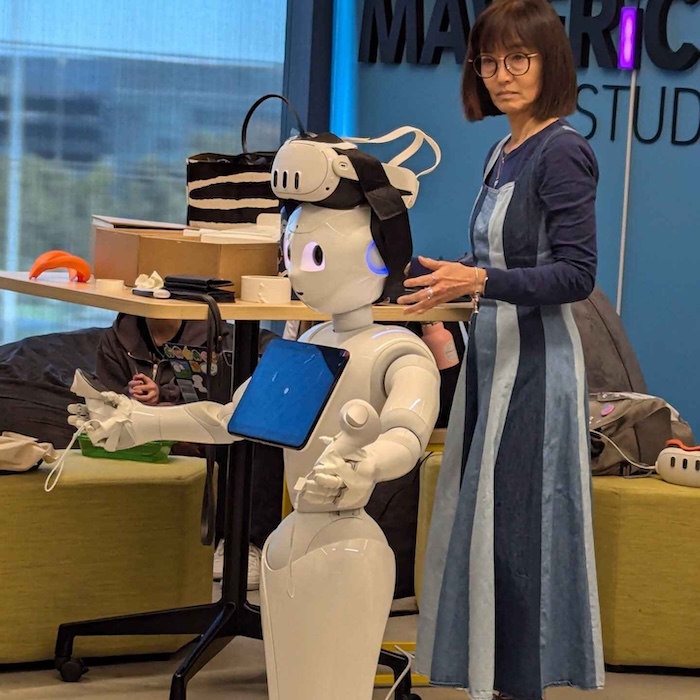The Future of AI in K-12 Education
Amy Eguchi of Education Studies predicts how AI will change learning
Story by:
Media contact:
Published Date
Story by:
Media contact:
Topics covered:
Share This:
Article Content
“AI could potentially change education drastically,” says UC San Diego education scholar Amy Eguchi, who is both excited and concerned about the prospect.
Technological innovation is nothing new to Eguchi. A teaching professor in the Department of Education Studies at UC San Diego’s School of Social Sciences, she has extensive experience in robotics and computing education. She’s been involved with RoboCupJunior – an international robotics competition for kids and teens – for more than 20 years. She also advises the Los Angeles Unified School District’s AI Task Force and leads a National Science Foundation-funded project to advance STEM learning in refugee communities. Thanks to this and other federally funded efforts, Eguchi has developed a deep understanding of how to apply emerging technologies in ways that serve students and schools.
While some may dream – or worry – about about a future with robot teachers, Eguchi says not so fast. Robots are increasingly used around the world for tasks like food delivery and cooking, and studies suggest they may be helpful in language practice and with students on the autism spectrum. But they’re still expensive, difficult to maintain, and far from widespread adoption in classrooms.
AI tools, on the other hand, are far more accessible. From questions about whether students are using AI to complete assignments to the rise of AI chatbot tutors, Eguchi says artificial intelligence is already “shaking up” education. We sat down with her to learn more.
What are some of the benefits and challenges of the growing use of AI in schools?
AI has three different sides: one is to use AI, one is to teach with AI, and one is to teach about AI. But somehow people are just talking about using AI. We need to talk about all three, and then we can talk about how to use it in classrooms.
Teachers need to fully understand how AI actually works so that they can make informed decisions on when and how to use it. I recently met with a kindergarten teacher who was very worried and asked me, ‘Do I really have to use AI with my kids? I don’t even know what it is.’ She was under such pressure, and that’s not healthy. That’s an incredibly difficult and unfair situation for teachers to be placed in. That's why AI literacy — and supporting teachers with the integration of AI literacy in their classrooms — is a main priority for me. It’s very important to slow down and make sure teachers feel comfortable and confident before integrating AI into schools.
It’s also important to think about how to use AI in age-appropriate ways and to address privacy issues. So there’s a lot of missing pieces at this point, but I am optimistic. AI has the potential to make our lives easier — potentially helping us become more productive and creative — if we know how to use it more like a collaborative partner.
How do these innovations contribute to the changing landscape of education? Are you fearful, hopeful, or something else?

I’m hopeful that this could be a long-awaited tipping point where teaching and learning will be drastically transformed, since education is one of the only systems that has not changed much since its inception.
AI is here to stay, so we have to decide to make it positive in the ways we want. If we don’t do anything, it could have negative effects.
This feels like a big change, but people were also worried when computers and smartphones were first introduced in schools. We have adapted to those and will adapt to life with AI too.
One of the fundamental goals of education is to prepare our students to contribute meaningfully to society. With things changing as rapidly as they are, we need to equip students with the competencies they’ll need to navigate and thrive in a constantly evolving world. We should emphasize learning how to learn and how to adapt.
With AI technology, teachers will need to change learning priorities. Mastering proficiency will not be as important as it has been. Students may need to place greater emphasis on learning how to analyze and evaluate content for accuracy, as current AI tools are not reliable for fact-checking. They will also need strong skills in editing and refining what they create.
Greater use of AI in the classroom could encourage a greater focus on deeper learning instead of a focus on memorization.
You are a teacher of teachers, and you offer a number of courses about teaching computation, including one on teaching with educational robots. What do you hope your students implement in their own future classrooms?

In my course, students practice using the educational robotics kits themselves before learning how to teach with them. It is very important that they get a grasp on these tools by problem solving and learning from their mistakes.
AI, robotics and computer science are unique from other subjects because many people do not have prior learning experience with them. For subjects like math and writing, students have a foundational understanding from their own education, so teaching about them feels more familiar. But since these tools are still new, we need to begin by engaging in our own learning experiences first.
Any parting thoughts on the future of AI in education?
AI has a lot of potential to do good in education, but we have to be very intentional about its implementation.
Also, keep in mind the connection between AI and robotics. From this point moving forward, robots will have AI embedded in them. That is allowing robots to process information much faster and in more sophisticated ways. They’ll be able to do a lot more tasks soon. It’s not at the level we see in the movies, but that could be coming down the pike.
Again, we need to be intentional about the implementation — and also make sure that all students and all teachers have access to high-quality learning opportunities.
AI has a lot of potential to do good in education, but we have to be very intentional about its implementation.
In addition to the NSF, Eguchi’s research has also been funded by the Yankelovich Center for Social Science Research and the Scratch Foundation. Eguchi is also part of a California Learning Lab AI FAST Challenge grant to UC San Diego and San Diego City College on "Acquiring Math Prerequisites Efficiently and Scalably with AI," led by Virginia de Sa of Cognitive Science in the UC San Diego School of Social Sciences.
Learn more about research and education at UC San Diego in: Artificial Intelligence
Topics covered:
Share This:
You May Also Like
UC San Diego is Strengthening U.S. Semiconductor Innovation and Workforce Development
Technology & EngineeringStay in the Know
Keep up with all the latest from UC San Diego. Subscribe to the newsletter today.






